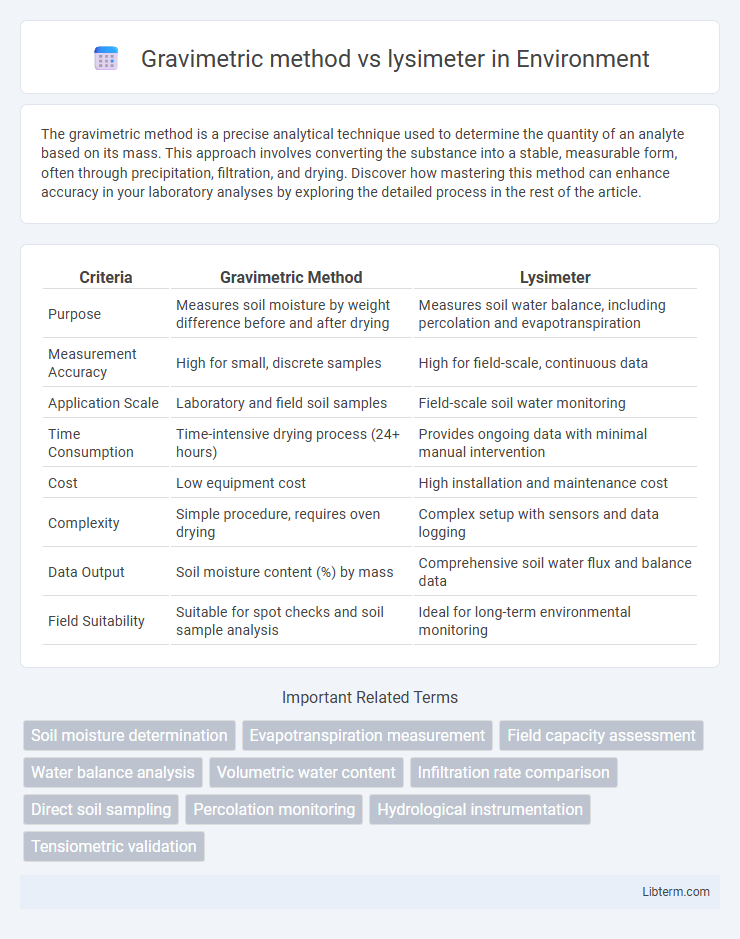The gravimetric method is a precise analytical technique used to determine the quantity of an analyte based on its mass. This approach involves converting the substance into a stable, measurable form, often through precipitation, filtration, and drying. Discover how mastering this method can enhance accuracy in your laboratory analyses by exploring the detailed process in the rest of the article.
Table of Comparison
| Criteria | Gravimetric Method | Lysimeter |
|---|---|---|
| Purpose | Measures soil moisture by weight difference before and after drying | Measures soil water balance, including percolation and evapotranspiration |
| Measurement Accuracy | High for small, discrete samples | High for field-scale, continuous data |
| Application Scale | Laboratory and field soil samples | Field-scale soil water monitoring |
| Time Consumption | Time-intensive drying process (24+ hours) | Provides ongoing data with minimal manual intervention |
| Cost | Low equipment cost | High installation and maintenance cost |
| Complexity | Simple procedure, requires oven drying | Complex setup with sensors and data logging |
| Data Output | Soil moisture content (%) by mass | Comprehensive soil water flux and balance data |
| Field Suitability | Suitable for spot checks and soil sample analysis | Ideal for long-term environmental monitoring |
Introduction to Soil Water Measurement Techniques
Gravimetric method and lysimeter are fundamental techniques in soil water measurement, each offering precise insights into soil moisture content and water balance. The gravimetric method involves direct sampling of soil, drying, and weighing to determine water content, providing high accuracy but limited temporal resolution. Lysimeters enable continuous monitoring of soil water movement and evapotranspiration by measuring drainage and changes in soil water storage, supporting comprehensive water balance studies over time.
Understanding the Gravimetric Method
The gravimetric method involves determining soil moisture content by measuring the weight difference of soil samples before and after oven drying, providing accurate and direct quantification of water present. This technique is widely used in research and agricultural applications due to its simplicity and reliability compared to lysimeters, which measure water balance over time but require complex installations. Gravimetric soil moisture assessment offers precise data essential for irrigation management and soil water deficit analysis.
Overview of Lysimeter Technology
Lysimeter technology provides precise measurement of actual evapotranspiration by capturing and analyzing water percolation through soil columns under natural conditions. Unlike the gravimetric method, which relies on periodic weighing of soil samples to estimate moisture content, lysimeters integrate environmental variables such as precipitation, temperature, and plant water uptake for continuous monitoring. This technology is essential in hydrological studies, irrigation management, and agricultural research, offering detailed insights into soil-water-plant interactions.
Principles of Gravimetric Soil Moisture Determination
Gravimetric soil moisture determination measures water content by weighing a soil sample before and after oven-drying to calculate moisture loss, based on the principle that water evaporates entirely during drying. This method provides direct and accurate soil moisture values essential for calibrating other techniques like lysimeters, which estimate water balance by collecting drainage from a soil column. Gravimetric analysis remains the standard reference method due to its simplicity and reliability in quantifying soil water content.
Types and Applications of Lysimeters
Lysimeters come in various types including weighing, non-weighing, and tension lysimeters, each designed for specific water balance and soil moisture studies. Weighing lysimeters accurately measure evapotranspiration and deep percolation by recording changes in soil mass, while non-weighing lysimeters typically assess drainage and solute transport through soil columns. Widely applied in agricultural research, hydrology, and environmental science, lysimeters enable precise monitoring of irrigation efficiency, nutrient leaching, and groundwater recharge, parameters critical for water resource management and sustainable farming practices.
Accuracy and Precision: Gravimetric vs Lysimeter Methods
Gravimetric methods provide high accuracy in soil moisture measurement due to direct water content determination by mass difference but may suffer from lower precision caused by sampling variability. Lysimeters offer improved precision through continuous monitoring of water flux and soil moisture changes over time, reducing spatial heterogeneity effects but may introduce errors from soil disturbance during installation. Both methods complement each other, with gravimetric analysis excelling in point-specific accuracy and lysimeters delivering reliable precision for dynamic water balance studies.
Advantages and Limitations of the Gravimetric Method
The gravimetric method offers high accuracy and simplicity in measuring soil moisture content by directly weighing soil samples before and after drying. It does not require expensive equipment, making it accessible for field and laboratory use, but is time-consuming and destructive, as it involves disturbing the soil and cannot provide continuous or real-time moisture data. Unlike lysimeters, which allow for ongoing, non-destructive monitoring of soil water balance, the gravimetric method is limited in temporal resolution and spatial representativeness.
Pros and Cons of Using Lysimeters
Lysimeters offer precise measurement of water balance by capturing percolation and evapotranspiration, providing real-time data on soil moisture dynamics and plant water use, which gravimetric methods cannot directly measure. However, lysimeters are costly, require complex installation and maintenance, and may not represent natural field conditions due to soil disturbance or scale limitations. Despite these challenges, lysimeters are invaluable for long-term hydrological studies and irrigation management due to their detailed, continuous data collection capabilities.
Practical Considerations: Cost, Installation, and Maintenance
Gravimetric methods require minimal initial investment and straightforward installation, making them cost-effective for small-scale soil moisture measurements. Lysimeters involve higher costs due to complex installation procedures, including excavation and equipment calibration, with ongoing maintenance needed to ensure accurate water balance monitoring. Maintenance for gravimetric sampling is low, primarily involving occasional soil collection and drying, whereas lysimeters demand regular system checks and potential repairs to prevent measurement errors and equipment degradation.
Choosing the Right Method: Gravimetric or Lysimeter?
Choosing between gravimetric and lysimeter methods depends on the precision and scale of soil moisture measurement required. The gravimetric method offers direct, accurate soil water content by weighing soil samples before and after drying, ideal for small-scale or laboratory settings. Lysimeters provide continuous, real-time soil moisture data on a larger scale, suitable for field studies and long-term monitoring.
Gravimetric method Infographic

 libterm.com
libterm.com